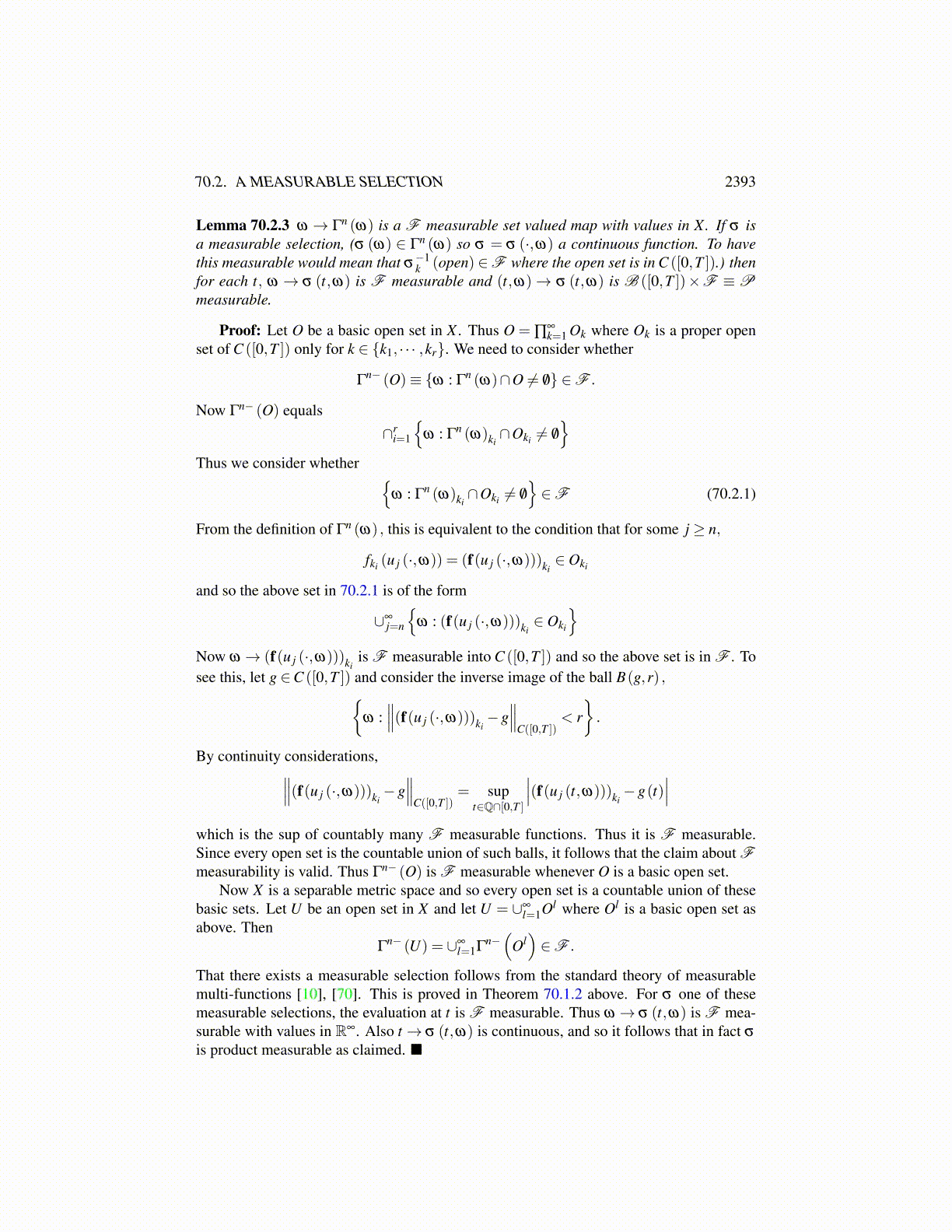
70.2. A MEASURABLE SELECTION 2393
70.2 A Measurable SelectionThis section deals with the problem of getting product measurable functions in a context ofno uniqueness. The following is the main result. It is stated in great generality because ithas fairly wide application although it will be used first in finite dimensions.
Theorem 70.2.1 Let V be a reflexive separable Banach space and V ′ its dual and 1p +
1p′ =
1 where p > 1 as usual. For n ∈ N let the functions t → un (t,ω) be in Lp′ ([0,T ] ;V ′) and(t,ω)→ un (t,ω) be B ([0,T ])×F ≡P measurable into V ′. Suppose there is a set ofmeasure zero N such that if ω /∈ N, then for all n,
supt∈[0,T ]
∥un (t,ω)∥V ′ ≤C (ω) .
Also suppose for each ω /∈ N, each subsequence of {un} has a further subsequence whichconverges weakly in Lp′ ([0,T ] ;V ′) to u(·,ω) ∈ Lp′ ([0,T ] ;V ′) such that t → u(t,ω) isweakly continuous into V ′. Then there exists u product measurable, with t→ u(t,ω) beingweakly continuous into V ′. Moreover, there exists, for each ω /∈ N, a subsequence un(ω)
such that un(ω) (·,ω)→ u(·,ω) weakly in Lp′ ([0,T ] ;V ′).
Note that the exceptional set is given. It could be the empty set with no change in theconclusion of the theorem.
Let X = ∏∞k=1 C ([0,T ]) with the product topology. One can consider this as a metric
space using the metric
d (f,g)≡∞
∑k=1
2−k ∥ fk−gk∥1+∥ fk−gk∥
,
where the norm is the maximum norm in C ([0,T ]) . With this metric, X is complete andseparable.
Lemma 70.2.2 Let {fn} be a sequence in X and suppose that the kth components fnk arebounded in C0,1 ([0,T ]). (This refers to the Hölder space with γ = 1.) Then there existsa subsequence converging to some f ∈ X. Thus if {fn} has each component bounded inC0,1 ([0,T ]) , then {fn} is pre-compact in X.
Proof: By the Ascoli−Arzelà theorem, there exists a subsequence n1 such that the firstcomponent fn11 converges in C ([0,T ]). Then taking a subsequence, one can obtain n2 asubsequence of n1 such that both the first and second components of fn2 converge. Contin-uing this way one obtains a sequence of subsequences, each a subsequence of the previousone such that fn j has the first j components converging to functions in C ([0,T ]). There-fore, the diagonal subsequence has the property that it has every component converging toa function in C ([0,T ]) . The resulting function in ∏k C ([0,T ]) is f.
Now for m ∈ N and φ ∈V ′, define lm(t)≡max(0, t− (1/m)) and
ψm,φ : Lp′ ([0,T ] ;V ′)→C ([0,T ])